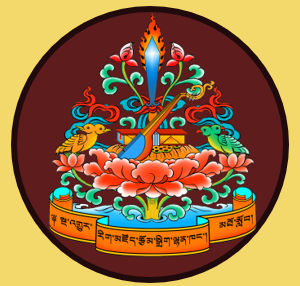Starting with this issue, we are featuring brief biographies of the six great Indian Authors, who are popularly known as the six ornaments of the world. They are: Lord Nagarjuna and Acharya Aryadeva, the composers of the root texts and commentary of Madhaymika philosophy or the tradition of the profound view respectively; Asanga and Vasubandhu, the composers of the root texts and commentary of the Chittamatrin tradition or the tradition of extensive conduct respectively; and Acharya Dignaga and Dharmakirti, the composers of the root texts and commentary of Valid Cognition respectively. As the biography of the Lord Nagarjuna has already been already included in a previous issue as part of the eight Indian Vidyadharas, we will hence introduce the remaining ones.
Acharya Aryadeva

According to the commonly known history in Tibet, Acharya Aryadeva was said to be born miraculously from lotus in the garden of a king in Sri Lanka. The king adopted him as his son and brought him up. He became one of the chief disciples of Nagarjuna and it is said that he tamed the non-buddhist scholar, Thubka Nagpo, who lived during that time. Other account says that he was none other than the accomplished master Karnariwa, who attained nirvana transforming his body into a rainbow during the time of Nargarjuna.
In his commentary of Aryadeva’s Four Hundred Verse Treatise, Chandrakirti also affirms that Aryadeva was the son of Sri Lankan king. As it accords with the popular Indian histories, here it will be elaborated according to these accounts.
The king of Sri Lanka, Patsa Shreegum had a son endowed with special qualities. When he grew up, he was entrusted with the royal responsibilities of the king but he was inclined towards becoming an ordained monk. So he was ordained by an abbot called Hama Dewa and had mastered the entire three baskets of teachings. Then he travelled to India for a pilgrimage, where he met with Lord Nagarjuna, who was on the way to Palgiri (Sri parvata). He relied on Nagarjuna and accomplished many attainments, like essence-extraction, and finally he was entrusted with teachings of essential meanings.
After the Lord Nagarjuna passed away into nirvana, Aryadeva benefited sentient beings by giving teachings in south India near Palgiri and establishing twenty four monasteries. With the supply of sustenance by female Yaksha called Kelwa Zangmo and other mountain gods, all these monasteries became the support for the religious institution of Mahayana Buddhism.
During that time, a non-buddhist Brahmin named Thubka Nagpo, from the East Indian city of Khorta was traveling around the country debating and defeating Buddhists scholars. Eventually his travels took him to the renowned Nalanda University. As the Buddhist scholars at Nalanda could not debate with the Brahmin they decided to invite Aryadeva and wrote a letter of invitation, and made supplicating prayers to Mahakala by offering sacrificial cakes and so forth. By the power of the prayers, a crow appeared miraculously from the heart of a self-arisen stone image of Mahakala. So they tied the letter to its neck and it flew toward the south and showed it to Aryadeva. He knew that the time had come for him to tame the Brahmin, and set out for Nalanda, travelling quickly with the tantric accomplishment of swift-footedness. On the way, a non-buddhist woman begged him for one of his eyes, as an eye of a scholar was required as a substance for accomplishing her yogic attainment, so he gave one of his eyes to that woman and arrived in Nalanda within a short time.
Firstly, he tamed all the defenders of Brahmins like the vampire in the form of a scholar, parrot, shameless Upasaka (lay practitioner), etc. Then he made a boundary with pieces of cloth blessed with the power of mantras. So even the Brahmin’s god Shiva, who usually used to enter his body to help him in debate, could not enter him. After that they debated for a long period of time and Aryadeva defeated the Brahmin three successive times. When the Brahmin tried to escape through the sky with miraculous power, he caught him with the power of mantra and imprisoned him in a temple. The Brahmin started to read Buddhist texts in the temple and finally came across the sutra where Buddha prophesied about him without any mistake. So the faith in Buddha grew stronger and stronger within his mind-stream and he regretted his past misdeeds towards the Buddha-dharma. Finally, he became a Buddhist monk and within a short time he became a master of the three baskets of Buddha’s teachings.
After taming the Brahmin , Aryadeva lived in Nalanda for a long period. Later he came back to the south and accomplished the great purpose for sentient beings. Eventually he entered nirvana at a place called Raganatha near Katsi after entrusting the teachings of essential meanings to his disciple Dachenzin Zangpo.
By Konchok Palmo
5th Year, NNNI


